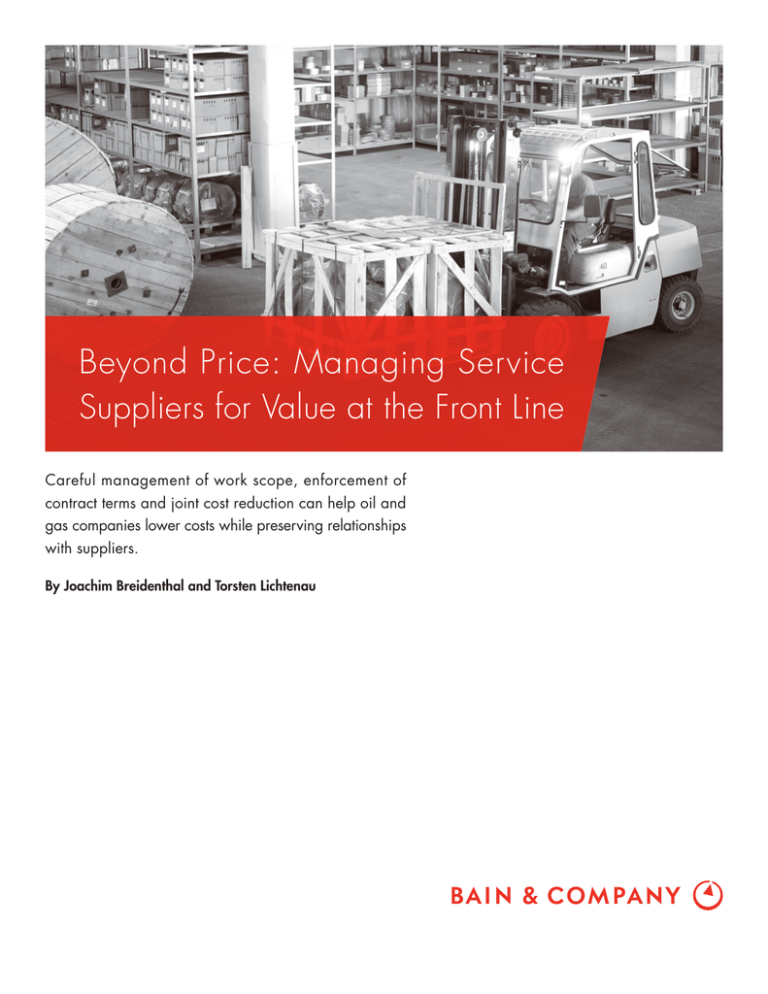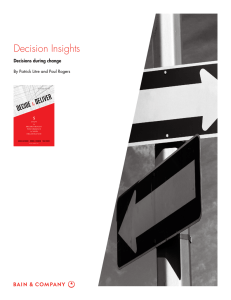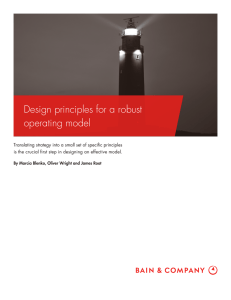
Beyond Price: Managing Service
Suppliers for Value at the Front Line
Careful management of work scope, enforcement of
contract terms and joint cost reduction can help oil and
gas companies lower costs while preserving relationships
with suppliers.
By Joachim Breidenthal and Torsten Lichtenau
Beyond Price: Managing Service Suppliers for Value at the Front Line
Every company in the oil and gas industry is focused on
reducing costs. Most start with aggressive negotiations to
reduce prices, and some get reductions of up to 40%. But
with oil and gas prices so low, that’s not enough.
Companies must also organize to manage supplier performance, especially in categories where service suppliers make up most of the external spending. This can
help them double their savings by carefully managing the
scope of what is being procured, ensuring that supplier performance is in line with what has been agreed upon and
working with suppliers to reduce costs together.
Procurement departments manage contracts, but operations teams oversee suppliers’ performance and
advise on ways to improve the value of the relationship.
•
Fit-for-purpose contracts. Contracts should spell out
not only the services to be provided but also the joint
expectations about improvements in key performance indicators (KPIs). One large petrochemicals
plant with a variable-pay service contract discovered
that costs had escalated in some categories when
suppliers were allowed to increase the scope of work.
They changed to fixed-resource, fixed-fee contracts,
added a mechanism for distributing available capacity across the plant, and saved more than 25%.
•
Shared KPIs that are tracked and improved. Supply
chain, operations and service suppliers should monitor critical indicators focused on value delivery, not
just process. Some KPIs might be common across
spending categories (for example, adherence to plan
or level of overtime), while others will be specific to
each category (such as using access methods other
than scaffolding).
Four barriers typically diminish the value a company gets
from suppliers:
•
Functional silos. Engineering specifies the requirement, procurement negotiates the contract, and
operations works with the supplier—but the three
functions don’t collaborate closely to get the most
out of the relationship and the contract.
•
Lack of clarity about what creates value. Operations
doesn’t have a clear view of what creates value in the
contract (for example, managing overtime or reducing work volume) or how operations itself may be
creating inefficiencies and extra costs for the supplier
(for example, onerous permitting processes that can
significantly reduce a service suppliers’ time on site).
•
Complex contracts. The front line does not have a
simple view of what the contract entails, what to ask
for and how they are performing, because it only
views the contract as a long legal document designed
to protect the company from lawsuits rather than to
manage suppliers.
•
Unproductive relationships. The relationship between
the front line and suppliers can either be too cozy or
too transactional, rather than a collaborative working
relationship that seeks to create value for both.
Oil and gas companies can unlock the full potential of
their supplier relationship by improving five key elements.
•
Clear decision roles. The bedrock of good collaboration
between functions is transparency in decision making.
Copyright © 2016 Bain & Company, Inc. All rights reserved.
To establish indicators, companies need to understand the total cost of ownership for a category, including factors that increase either the supplier’s
costs (for example, late planning of work that disrupts
schedules) or the buyer’s (for example, rework due to
poor welding). Companies can then use these metrics
to manage performance. One industrial company discovered significant costs resulting from scaffolds
erected several days before maintenance work began
and left standing for days after. By tracking the metric
and displaying the data, the front line reduced the
costs of these leftover scaffolds by more than 40%.
•
Tools to help the front line decide on work scope, volume and overtime. Two types of tools that work particularly well are the contract-on-a-page and scoping
tools. The contract-on-a-page—sometimes reduced to
its main points on a card that can hang on a lanyard—
outlines the most important aspects of the contract
and tells frontline staff how to reduce service cost (see
Figure 1). The scoping tool helps the front line consider the most cost-effective way to do a job. For
Beyond Price: Managing Service Suppliers for Value at the Front Line
instance, one client created a simple chart that described
the difference in cost and risk from using scaffolding,
rope access, scissor lifts or forklift cages to access key
points in the plant. The front line used this on a daily
basis to make decisions on the best way to do a job
and substantially reduced costs as a result.
•
Ongoing performance discussions with service suppliers on how to work together to create value, with
rigorous follow-up to address any performance gaps.
Monthly performance reviews are a good way to complement strong daily management, providing an opportunity to acknowledge successes and identify opportunities for improvement. It is important to plan
these reviews carefully, making sure key staff from
both sides are in the room and ensuring follow-up. In
our experience, these sessions have an immediate effect on performance. In one recent conversation, the
supplier offered multiple solutions that reduced the
buyer’s costs without diluting the supplier’s profits.
Companies with strong supplier performance management in place have found that not only do they
yield additional near-term value, but they also create
tools that empower the front line to keep costs down,
improve supplier relationships and release some of
the tension between procurement and operations.
One client transformed its supplier relationships by
piloting these measures in one category and eventually rolling them out across all categories, saving 10%
to 15% in less time than contract negotiations would
have taken.
With oil priced as low as it is, every dollar counts. Aggressive price renegotiations are one important tactic, but operators and suppliers can create additional value through
systematic supplier performance management at the front
line. To do this, operators and suppliers will need to break
down silos and identify what creates value in the contract.
Doing so creates sustainable benefits that will remain
even when oil prices and rates eventually recover.
Joachim Breidenthal is a partner with Bain & Company
in Johannesburg, and Torsten Lichtenau is a partner in
the Bain London office. Both work with Bain’s Global
Oil & Gas practice.
Figure 1: A contract-on-a-card gives a clear, concise overview of the supplier’s and customer’s responsibilities
Scope of services contract
Describes the services to be provided, including what elements are and are not included
Key contract features
Details the responsibilities of the service and the customer and how
to manage change
• If scope changes, provider has five days to gain approval
• If provider breaches the contract, penalties apply
• Cancellation fees apply if the customer cancels the work
Contract watch-outs
Select rates and factors
Details of billing, labor rates and cost overruns
• Standard rates are multiplied as follows:
– Urgent work (1.15x)
– Emergency work (1.2x)
– Weekend or holiday work (1.6x)
• Equipment left after work is complete can increase the service
provider’s costs
Roles and responsibilities
Key items for customer to oversee to reduce costs associated with
service provider’s rates
Description of roles and responsibilities of service provider
and customer
• Minimize the use of unnecessarily expensive equipment or services
• Customer is responsible only for providing water, electricity and
200 meters of working space
• Minimize the equipment rental time by removing it promptly after
work is complete
• Reduce the risk of scope change by accurately estimating work
• Service provider is responsible for providing safe, fit-for-purpose
equipment with weekly inspections
• Service provider must notify customer as soon as it is aware it
cannot meet a production schedule
Source: Bain & Company
Shared Ambit ion, True Results
Bain & Company is the management consulting firm that the world’s business leaders come to when they
want results.
Bain advises clients on strategy, operations, technology, organization, private equity and mergers and acquisitions. We develop practical,
customized insights that clients act on and transfer skills that make change stick. Founded in 1973, Bain has 53 offices in 34 countries,
and our deep expertise and client roster cross every industry and economic sector. Our clients have outperformed the stock market 4 to 1.
What sets us apart
We believe a consulting firm should be more than an adviser. So we put ourselves in our clients’ shoes, selling outcomes, not
projects. We align our incentives with our clients’ by linking our fees to their results and collaborate to unlock the full potential of their
business. Our Results Delivery® process builds our clients’ capabilities, and our True North values mean we do the right thing for
our clients, people and communities—always.
Key contacts in Bain’s Global Oil & Gas practice
Americas
Europe, Middle East and Africa
Riccardo Bertocco in Dallas (riccardo.bertocco@bain.com)
Pedro Caruso in Houston (pedro.caruso@bain.com)
Ricardo Gold in São Paulo (ricardo.gold@bain.com)
Eduardo Hutt in Mexico City (eduardo.hutt@bain.com)
Jorge Leis in Houston (jorge.leis@bain.com)
Rodrigo Más in São Paulo (rodrigo.mas@bain.com)
John McCreery in Houston (john.mccreery@bain.com)
John Norton in Houston (john.norton@bain.com)
Ethan Phillips in Houston (ethan.phillips@bain.com)
José de Sá in São Paulo (jose.sa@bain.com)
Akram Alami in Dubai (akram.alami@bain.com)
Lars Jacob Bø in Oslo (larsjacob.boe@bain.com)
Joachim Breidenthal in Johannesburg
(joachim.breidenthal@bain.com)
Luca Caruso in Moscow (luca.caruso@bain.com)
Juan Carlos Gay in London (juancarlos.gay@bain.com)
Lili Chahbazi in London (lili.chahbazi@bain.com)
Christophe de Mahieu in Dubai (christophe.demahieu@bain.com)
Peter Jackson in London (peter.jackson@bain.com)
Torsten Lichtenau in London (torsten.lichtenau@bain.com)
Olya Linde in Moscow (olya.linde@bain.com)
Alain Masuy in Dubai (alain.masuy@bain.com)
Roberto Nava in Milan (roberto.nava@bain.com)
Peter Parry in London (peter.parry@bain.com)
Tiziano Rivolta in Milan (tiziano.rivolta@bain.com)
Karim Shariff in Dubai (karim.shariff@bain.com)
Natan Shklyar in Moscow (natan.shklyar@bain.com)
John Smith in London (john.smith@bain.com)
Luis Uriza in London (luis.uriza@bain.com)
Asia-Pacific
Sharad Apte in Bangkok (sharad.apte@bain.com)
Francesco Cigala in Kuala Lumpur (francesco.cigala@bain.com)
Lodewijk de Graauw in Perth (lodewijk.degraauw@bain.com)
Dale Hardcastle in Singapore (dale.hardcastle@bain.com)
Brian Murphy in Perth (brian.murphy@bain.com)
For more information, visit www.bain.com









